Star Wars Rebellion – May the 4th be with you!
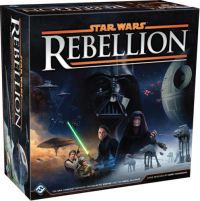
Every once in a while a game comes along that totally captures my attention.
Star Wars Rebellion is such a game!
It was released last year by Fantasy Flight Games and once again, the completely knocked it out of the park!
By a completely lucky coincidence, I was traveling to Minneapolis on business last April when a launch event was happening at the FFG Game Center. I didn’t know it when I planned my trip, but was excited to find the event listed on the FFG website: “Rebellion designers Corey Konieczka and Steve Kimball will be in the store to chat, answer questions, and sign copies of your Star Wars Rebellion game”.
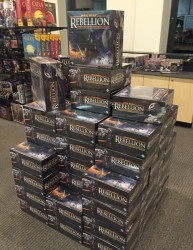
However, by an unlucky turn of events, my flight was delayed 3 hours due to weather and I didn’t get to the FFG Game Center until after the event was over. Major bummer!
So all I left with was a photo of the stack of Star Wars Rebellion games in the store and hopes of playing it soon in the future.
It turns out that my first play of Star Wars Rebellion lived up to my hopes and became one of my Top 11 Game Experiences of 2016.
And thanks to Miniature Market, we now have our own copy and I’m lovin’ it!
Star Wars Rebellion is a wonderful foray into the epic battle between the Rebel Alliance and the Galactic Empire. If you’re looking for a board game that immerses you into the Star Wars universe, this is it!
And it’s a perfect board game to play on #StarWarsDay!
How to play Star Wars Rebellion
Unlike many of the other games we’ve reviewed, Star Wars Rebellion isn’t a quick game to learn and play. It’s not a light game you’re going to pull out to play before bed.
Unless your bedtime is 3 hours away!
Star Wars Rebellion is a full course meal of a game that takes a solid couple hours to play. But, oh is it worth it!
Players take the sides of either the Galactic Empire or the Rebel Alliance – each with their unique abilities and options to play and each with their own way to win. The Imperial player must find and conquer the Rebel base and the Rebel player must achieve a number of objectives before it’s too late.
Rather than cover every element of the game play, I’ll share enough to give you a good taste of the flow of the game before diving into what I love about the game.
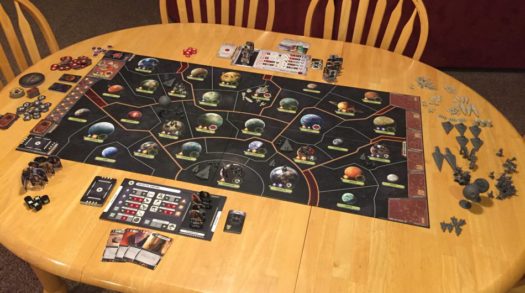
Set Up
Players then gather their faction sheet, leaders, miniatures, loyalty markers, mission cards, and action cards.
The Rebel player prepares the Objective deck of cards and draws one to their hand.
For the first game, there’s a prescribed way to set up the initial state of the galaxy with troops and control of certain systems. Thereafter, players can follow the steps for their own configuration of system loyalty and starting units.
The Time marker is placed on the first spot on the time track and the Reputation marker is placed on space 14. (The game ends in favor of the Rebel player if the Time marker and Reputation marker meet at the same space on this track.)
The Rebel player than selects the system where they’ll hide their Rebel base and places the matching Probe Droid card under the side of the board.
Each player takes their starting mission cards and draws 2 cards from his mission deck to create his starting hand.
Then the battle is on!
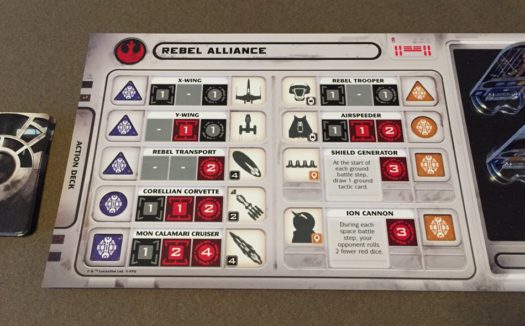
Player turns
The game is played over a series of rounds that consist of 3 phases: Assignment, Command, and Refresh.
During the Assignment phase, players secretly assign their leaders to specific missions or leave them queued up and ready for opposing the other player’s missions.
During the Command phase, players send their leaders out on the missions they’ve chosen or use them to move forces into other systems and start combat.
During the Refresh phase players do a bit of resetting of their leaders and their hand of cards.
Assignment Phase
The Rebel player starts by assigning his leaders to missions from his hand of cards. He places the mission card face down and places 1 or 2 leaders on top of the card. Each mission card has a skill requirement that must be met by the assigned leaders in order to be attempted.
He can also choose to not assign a leader to a mission and instead place it on his faction sheet in a “leader pool” to stand ready.
When the Rebel player is finished, the Imperial player then assigns his leaders.
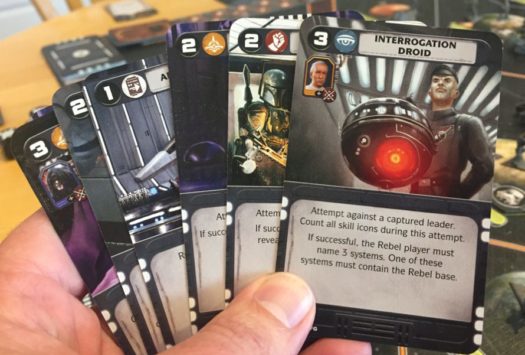
Command Phase
Starting with the Rebel player, players take turns either Activating a System, or Revealing a Mission.
Activating a System means the player takes a leader from their leader pool not assigned to a mission and places it in a system adjacent to one where he has units. He can then move in units from adjacent systems to where his leader is. If there are opposing units in that system, Combat occurs.
Revealing a Mission means that a player turns over the mission card of one of his assigned leaders and carries out that mission.
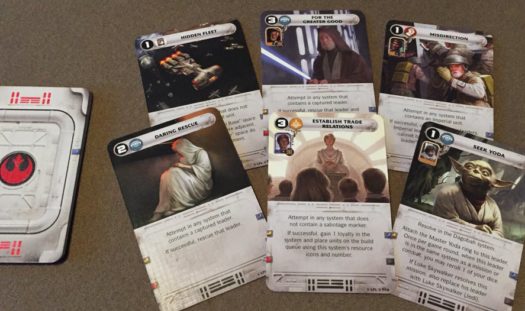
Some missions simply resolve while some must be “attempted”. When a player attempts a mission, the opposing player may play a leader from their leader pool to oppose the mission. Both players then roll a number of dice based on symbols of their leader and compare results. If the mission succeeds, the action is carried out. If the mission fails, nothing happens and play proceeds to the other player.
During play, the Rebel player works to fulfill Objectives he has in his hand. When an Objective is achieved, he reveals the card and advances the Reputation marker down the track the indicated number of spaces.
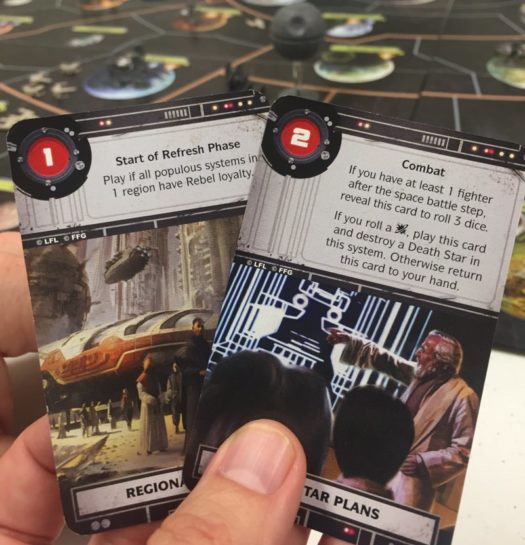
Combat
When vying for control of the galaxy, inevitably there’ll be clashes of might along the way. When both sides meet up in a system, they resolve Combat.
First players draw blue and orange Tactic cards equal to the number indicated on their leaders in battle. Then each resolves a combat round in which each side performs one attack. If both players have units in space in the system, the first combat is in space. And if both players have units on the planet, they then combat on ground.
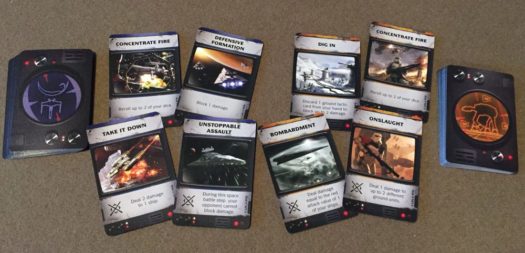
In an attack, both players roll a number of dice according to the units battling (as shown on faction sheet). Players may also be able to draw more Tactic cards or use them to enhance their results. They then compare symbols and assign damage to the units in battle.
If a unit takes damage equal to or exceeding its health it’s destroyed.
After a combat round, players can choose to retreat. If both still have units in the system, another combat round takes place.
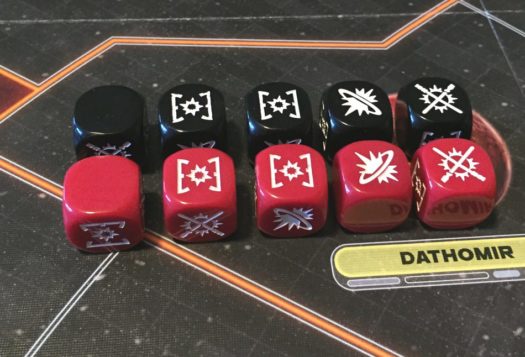
Refresh Phase
During this last phase in a round each player retrieves their leaders and draws 2 mission cards to their hand.
The Rebel player draws 1 Objective card to his hand and the Imperial player launches a probe droid. To launch a droid, he draws 2 cards from the Probe deck and keeps them secret. These cards show systems where the Rebel base cannot be hidden (because the Rebel base Probe Droid card is under the side of the board).
The Time marker is advanced one space on the time track, which may trigger a couple actions depending on the space. It may be that new leaders are recruited and/or new units are built. Then each player slides all units one space down his build queue. Any units that come of the board can now be deployed to loyal or subjugated systems.
Then a new round begins.
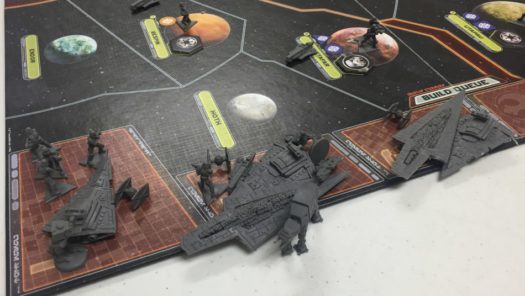
Winning the Game
Players continue through multiple rounds until on side wins.
The Imperial player immediately wins if he finds and conquers the Rebel base’s system.
The Rebel player immediately wins if the Reputation marker and the Time marker are in the same space on the time track.
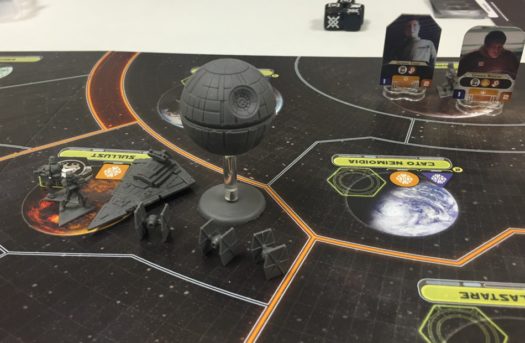
What I love about Star Wars Rebellion
While I’ve given a quick rundown of the basic flow of play in Star Wars Rebellion, it’s hard to get a good feel for the game without really playing it. And that’s because so much of the beauty of the game is in the actual game play.
Star Wars Rebellion truly feels like an epic battle between the Empire and Rebels. And no matter which side you’re playing, you feel the pressure.
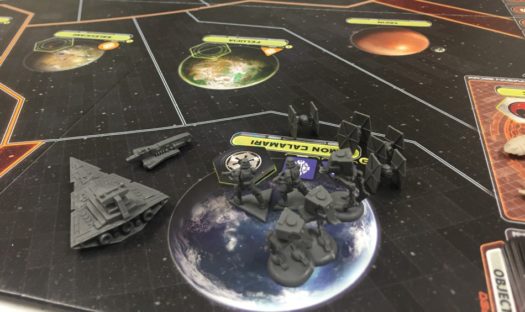
As Rebels, you don’t know how you’re going to withstand the immense power of the Empire. The amount of units they have at their command is daunting. Not only do they have a lot of troops on the board to begin the game, but their build queue also seems to spit out more at will.
As they hunt you down, you totally feel the pressure that they’re going to find your hidden base soon. So you try to scrap together any little hits you can against their massive forces. Completing Objectives are the major way to advance the Reputation marker and get it to reach the Time marker before your base is found and conquered.
As the Empire, the hunt for the Rebel base is challenging. Sure you have a lot of forces at your command, but they could be hidden anywhere in the immense galaxy. And you can’t waste time because you’re racing against the clock to find and destroy them.
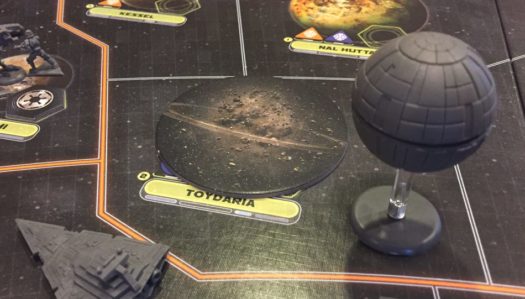
I also love how thematic the game is. And it’s not just visually.
Yes, the miniatures are awesome. And the artwork on everything is straight out of the Star Wars universe. But the missions and objectives themselves are all very well tied to Star Wars. From trying to steal the Death Star plans and rescuing captured leaders to seeking out Yoda to improve Luke’s abilities, the Rebel player truly feels like he’s in the midst of Star Wars. The same thing is true for the Imperial player who can send out bounty hunters, interrogate capture leaders for information about the location of the rebel base, or even turn Rebel leaders to the Dark Side.
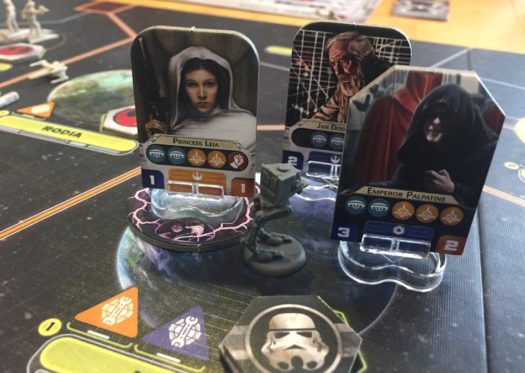
Another thing I love about the game is how it builds to a nice crescendo.
Players each start with 4 leaders at their command and get to recruit new leaders along the way. So at the start of the game, players can only work to complete a couple missions. But as you get more leaders, you can send them out on more missions. Which means you’ll have a lot of options at your disposal. And choosing where to deploy your leaders and troops keeps you thinking the whole time. Add to that the fact that sending all your available leaders out on missions means that you won’t be able to oppose the other player’s missions.
So while you may want to accomplish a bunch of missions in a round, it’s wise to hold some leaders back so when your opponent attempts to complete a mission you can move your leader into that system to oppose them.
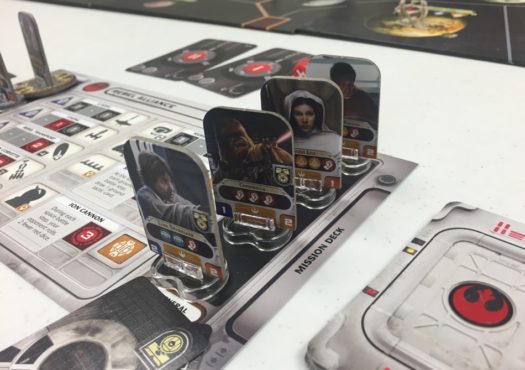
For a game that includes a lot of strategic planning and tactical maneuvering, Star Wars Rebellion also has a fair amount of luck that can thwart the best-laid plans. It also makes every game play out differently. Because of the dice rolls, not every mission will succeed. Because of dice rolls, even a discovered Rebel base may not be conquered. And that keeps the tension high throughout the game.
Star Wars Rebellion is full of trying to outguess and outmaneuver your opponent. And I love that thoughtful game play – especially when I get to do it in the Star Wars universe.
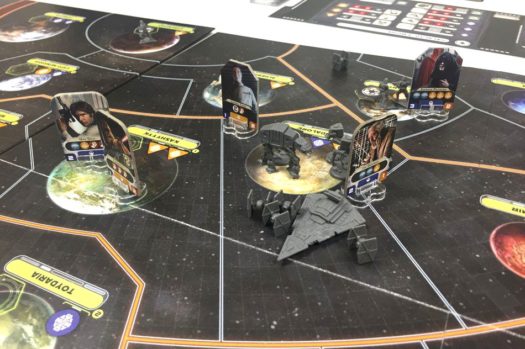
Even though games will last a couple hours, the time flies by.
Because of all the thoughtful choices every turn, players are constantly engaged with the game. There’s no downtime even when it’s not your turn. That’s because each player has choices to make based on what their opponent is doing – like choosing whether to oppose the mission they’re attempting. And in the hunt for the Rebel base each player is also trying to decipher the moves of their opponent as well. As a Rebel player, how can you keep your location secret yet also safely protected? As the Imperial player, can you infer the location of the Rebel base from some of the choices the Rebel player is making?
It’s a big cat-and-mouse game that’s loads of fun.
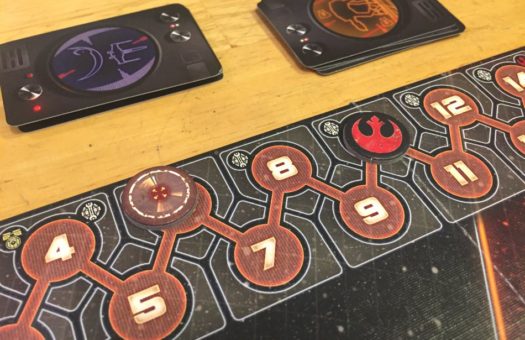
Star Wars Rebellion can be played with 4 players, but it’s most enjoyable with just 2.
The first time I played Star Wars Rebellion was with 4 players and I had a great time. In a 4-player game, players use the backside of the faction sheets and must divide their leaders between players. Because of the nature of the game, players have to coordinate everything they do. While two heads may be better than one when it comes to thinking through options, it also adds a bit to the complexity of the game and makes it take longer to play.
In a 2-player game, all the decisions are yours and the fate of your troops lies completely on your shoulders. And it’s wonderful.
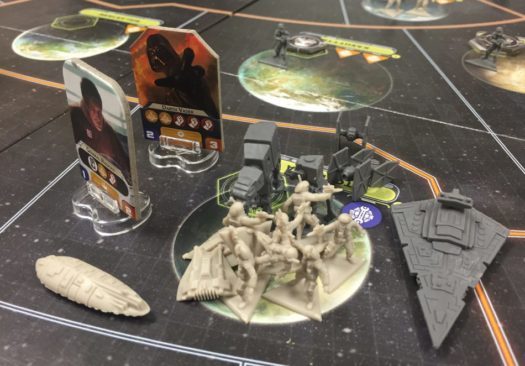
Even when the Rebel base is found, it doesn’t mean the game is over.
The first time I played Star Wars Rebellion, when the Empire discovered the Rebel base, we thought the game was over. My teammate and I were playing the Rebels and were ready to pack it in. But due to the dice rolls, one small Rebel unit survived the onslaught! That round we had also chosen the mission of moving the Rebel base, so as the final mission, the Rebel base was successfully moved and we lived to see another day.
The funny thing is that it happened again!
The Empire once again discovered our new hidden base and we survived to move the base another time (though locations left were very limited).
In the end, we pulled off enough Objectives to move the Reputation marker to the same space as the Time marker and win the game!
It was epic!
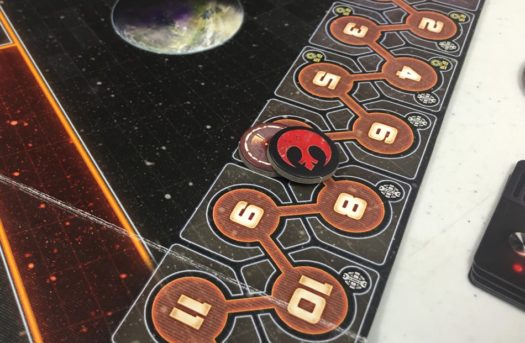
I could go on and on about Star Wars Rebellion, but the last thing I’ll mention I love about the game is the aftermath.
You know you’ve got a good game when players continue to talk about it long after the game is over. And that’s the case with Star Wars Rebellion.
When the games ends, we take a big breath and relive how the game played out. Everyone has something to say about different points in the game – what they thought would happen, what their plans were, how elated or devastated they were with certain die rolls, and so on.
Yet it doesn’t even end there. Months later the stories continue – like the game where I captured Princess Leia, successfully turned her to the Dark Side, and then sent her on a mission that ultimately captured the Rebel base.
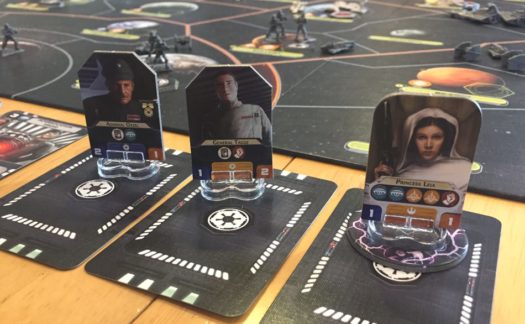
You can bet I’m excited to play Star Wars Rebellion for #StarWarsDay!
May the 4th be with you!
Zen Bins Star Wars Rebellion custom trays are just as epic
When you get a game the size of Star Wars Rebellion with lots of miniatures, tokens, and various card decks, you naturally think of how you’re going to store everything (because FFG games don’t come with much in the way of organization).
Naturally we first turn to baggies. We bag all the tokens. We bag the different card decks. We may even bag some of the smaller miniatures. But then we just toss them all in the center of the game box.
Well, there’s a much better solution – Zen Bins!
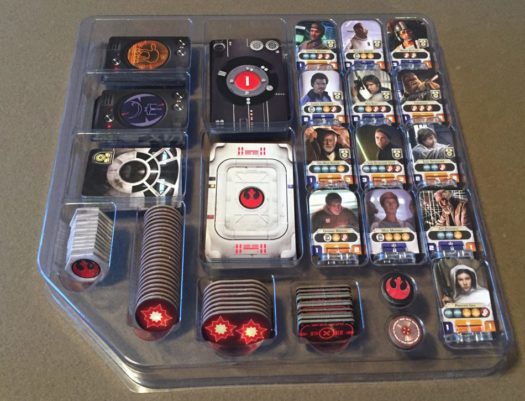
The best part is that Zen Bens aren’t just a good storage solution; they’re super helpful throughout the game.
With so many miniatures, items, and cards, everything will take up a ton of table space. The beauty about Zen Bins is that you can keep everything in their trays and just pull them as needed during game play.
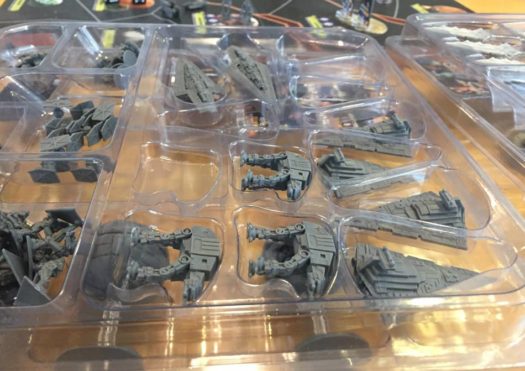
Zen Bins for Star Wars Rebellion includes 4 high quality clear PVC trays that are exceptionally functional. All the big and medium miniatures have a dedicated space and the smaller items have group sections.
The spaces for the leaders are also very well formed where they stay slightly tilted so they’re easy to find and grab.
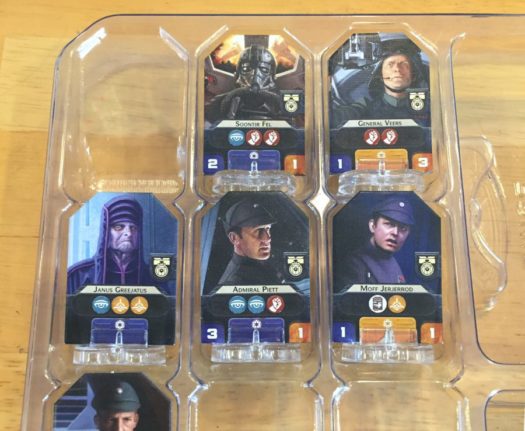
One of the things we really like about the trays are the sections for cards. Not only do they have ample space for even sleeved cards, they edge had a ridge in the bottom so that you merely need to press on one side of the deck and the other side pops right up!
So simple to get out!
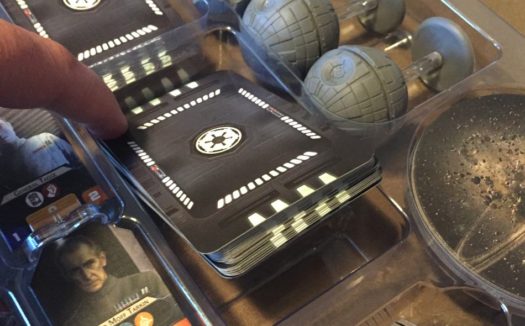
Plus all the spaces in the tray are clearly marked so you know which items go in which spaces.
The trays also nest perfectly with each other for stacking in the game box.
Yet Zen Bins’ thoughtful construction doesn’t end there.
They even include a sticker that you can place inside the game box lid that shows the order in which to stack the trays in the box!
That way all components are snuggly set so you can even store this massive game box upright on your game shelves! (That’s how we like to store our games in the closet.)
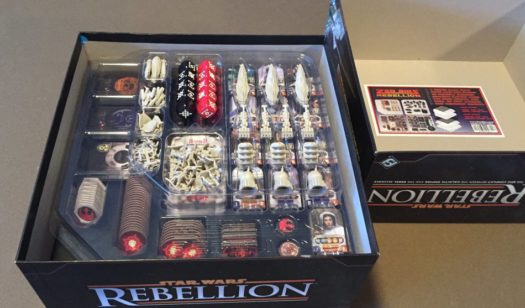
So when you’re buying your copy of Star Wars Rebellion, make sure to grab a Zen Bins Rebellion tray set as well!
We’d like to thank Miniature Market for a review copy of Star Wars Rebellion and Zen Bins for a review set of custom Rebellion trays.



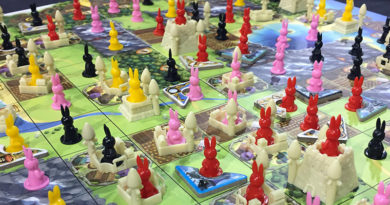
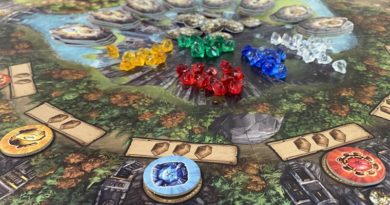
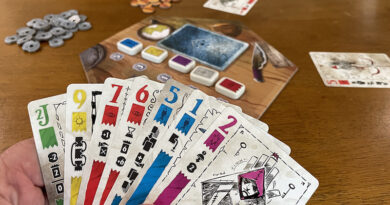
This one’s been on my “must play” list since I first heard the buzz (which just continues to increase).
Due to the time commitment I haven’t yet found a good opportunity to learn it.